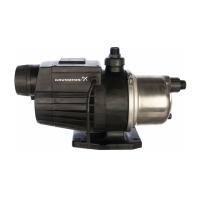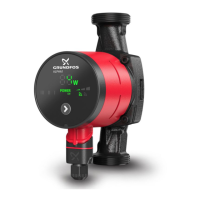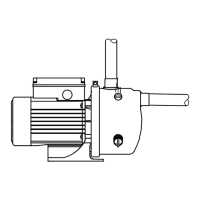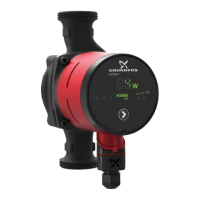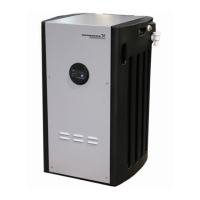7.4.3 Startup
To start up a BMSX system, proceed as follows:
1. All valves must be in their normal operating positions.
2. Start the raw-water feed pump (1). When the raw-water feed
pump is started, the system is filled with water. Make sure that
the entire system is vented. The feed flow (14) through the
pressure exchanger (22) may or may not cause the rotor to
begin rotating. Rotation will be confirmed by a humming noise.
3. Adjust the flow rate and pressure within the maximum and
minimum values stated on the PX nameplate.
Never operate the main high-pressure pump without
the BMS hp pump. An interlock must be installed, so
the high-pressure pump will automatically shut down if
the booster pump shuts down.
1
2
4
15
14
13
11
7
8
9
17
18
19
12
20
21
23
22
16
5
6
24
25
26
10
A
3
TM059619
Starting the seawater feed pump
See the description of the position numbers in the section on
before startup.
4. Adjust the concentrate valve (23) to the system flow.
5. Vent the system.
6. When you have filled the system with water and vented it, see
the BMS hp startup procedure.
The maximum flow rate of the pressure exchanger
must never be exceeded. See the nameplate of the
pressure exchanger.
WARNING
Pressurized system
Death or serious personal injury
‐ The BMS hp pump must not run against a closed
outlet valve for more than 5 seconds.
‐ Ensure a minimum liquid flow through the pump by
connecting a bypass or drain to the outlet side of
the pump. The drain can be connected to a tank.
7. Start the BMS hp pump (13). See the section on startup in the
section on BMS hp pumps.
1
2
4
15
14
13
11
7
8
9
17
18
19
12
20
21
23
22
16
5
6
24
25
26
10
A
3
TM059620
System pressure and flow, BMS hp
See the description of the position numbers in the section on before
startup.
The rotor speed will increase, and remaining air will be released
from the pressure exchanger. Vent any remaining air from the
system.
Adjust the frequency converter of the BMS hp pump (13) on the
outlet side of the pressure exchanger (22) until the low-pressure
seawater inlet flow (16) equals the calculated seawater flow (14).
To achieve a balanced flow rate through the pressure exchanger
(22), use the flowmeters installed on the low-pressure seawater
inlet pipe (16) and the high-pressure seawater pipe (14). All flow
rates in and out of the pressure exchanger (22) must be balanced
to within 5 % for optimum operation.
Operating the pressure exchanger with unbalanced flow
rates may result in contamination of the seawater feed by
the concentrate and consequently lower efficiency.
A lower flow rate in the seawater inlet than the seawater outlet will
result in lower permeate quality, increased feed pressure and higher
energy consumption. We recommend that you use a slightly
oversized BMS hp pump (13) to handle projected membrane
concentrate flows, taking seasonal variations, membrane fouling
and manifold losses into account. The flow rate and pressure of the
BMS hp pump (13) must be controlled with a frequency converter.
Neither the low-pressure nor the high-pressure flow
through the pressure exchanger must ever exceed the
rated maximum flow rate. The only reliable way to
determine the flow rates is to use a low-pressure
flowmeter (16) or a high-pressure flowmeter (14),
respectively.
To start up a BMS hs pump (6), proceed as follows: see the section
on startup in the section on BMS hs pumps.
17
English (GB)

